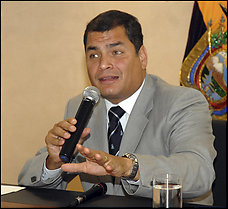December 13, 2008
Ecuador's default: how to tame the angry Rafael Correa
(This article was co-written with Chris Cook; although the final presentation was done by me, so I have mangled his ideas somewhat!)

The basic story: Ecuador's government is pissed & angry with the debt issuances of previous governments: accusations of bribes, misconduct, EHMs, etc. And, they are broke, or broke enough to suggest default. And it was an election promise!
So why not default? Let's run the thought experiment.
Argentina did it, and survived, or at least that theory is popular in some circles. If this were to happen, what do future partners do, like Venezuala, or the emerging Banco del Sur? Kick the Ecuadorean's sorry tail all the way to Galapogas islands, join them in default, or think about how to adopt?
It needn't be that way. The fundamental problem is that the debt has migrated from an honest contract to a dishonest circle of mutually supporting pieces. This structure no longer helps any of the participants. So here's a plan to help any bankrupt country to move to the future:
- Default on the lot?
- adopt a Peer to Peer system of issuance and trading, as found in this recent FT award, and as epitomised by zopa.com,
- move the banking sector across to a service provision model, based on p2p credit
- structure issuances as debt/equity sharing (consider LLPs). This means that bond holders are no longer simply holders of debt, they are partners and investors,
- back the instruments with guarantees provided by mutual societies; being a member automatically gives you not only the guarantee but the incentive to look after the downstream risks,
- then, in the bankrupcy of all the debt, replace all the old broken instruments with new equity/debt sharing instruments.
OK, so maybe we skip point 1 because we want to retain some friends. There are some pretty bad punishments that the financial world can levy you with. But think of the rest.
This is a good future model for banks. p2p investment has higher margins, and the banks do not have to risk their own capital to play. Indeed that's where they want to be, c.f., securitization, and we could argue they are already there.
But, where they are now, the risks are not properly spread to those who care for the instruments, so, say hello to financial crisis.
We just have to go the next step by engaging the players end-to-end. The real essence is to move the financial issuance of debt across to a flexible creation of debt/equity balanced contracts between issuers and investors. The details are for later.
(It goes without stressing, in this new financial structure, we would need the ability for smaller issuers to create flexible contracts together.)